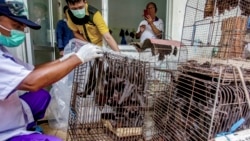Researchers have discovered six new coronaviruses in bats while studying how diseases can pass from animals to humans.
The scientists said the coronaviruses – found in bats in Myanmar – are not closely related to the coronavirus now affecting many parts of the world.
The research was led by scientists from the Smithsonian’s Global Health Program in Washington, D.C. The findings were recently reported in a study in the publication PLOS ONE.
The researchers said the six new coronaviruses have never been discovered anywhere in the world.
The U.S. Centers for Disease Control and Prevention (CDC) says that coronaviruses “are a large family of viruses that are common in people and many different species of animals.” The CDC adds that it is rare for animal coronaviruses to infect people and then spread among the human population.
However, there have been major disease outbreaks caused by coronaviruses in humans. Bats have been linked to some of them. The viruses responsible for diseases SARS and MERS were linked to bats. The CDC says the new coronavirus, which causes the disease COVID-19, also came from bats.
Health experts estimate that thousands of coronaviruses are present in bats, with many still undiscovered.
The Smithsonian team worked with researchers in Myanmar on a project aimed at identifying new diseases that are zoonotic –meaning they can spread from animals to humans. The project, called PREDICT, is supported by the U.S. Agency for International Development (USAID).
Researchers working on the project say zoonotic diseases represent about 75 percent of new diseases affecting humans. One of their goals is to study how contact between humans and wildlife can lead to coronavirus infections in people.
The team centered its research in areas where humans were most likely to come into close contact with local wildlife. Among the team members were representatives from Myanmar government agencies.
The researchers collected 759 samples of saliva and waste from bats in the areas from May 2016 to August 2018. After examining the samples, they identified the six new kinds of coronavirus. The team also discovered a coronavirus found in other parts of Southeast Asia, but never before in Myanmar.
Marc Valitutto is a former wildlife veterinarian with the Smithsonian’s Global Health Program. He was the lead writer of the study. He said in a statement that widespread disease outbreaks like COVID-19 should “remind us how closely human health is connected to the health of wildlife and the environment.”
“The goal is to prevent the virus from getting into humans in the first place,” Valitutto told Smithsonian Magazine.
He added that future research will seek to learn more about how coronaviruses behave in animals. For example, what permits the viruses to mutate and spread to other species. Such research can help reduce the possibility of future pandemics, Valitutto said.
Suzan Murray is the director of the Smithsonian’s Global Health Program. She said many coronaviruses do not present risks to humans. However, she noted identifying them early on in animals can be an effective way to investigate possible disease threats. “Vigilant surveillance, research and education are the best tools we have to prevent pandemics before they occur,” Murray said.
I’m Bryan Lynn.
Bryan Lynn wrote this story for VOA Learning English, based on reports from the Smithsonian’s Global Health Program, PLOS ONE and the CDC. Mario Ritter, Jr. was the editor.
We want to hear from you. Write to us in the Comments section, and visit our Facebook page.
________________________________________________________________
Words in This Story
species – n. a set of plants or animals in which the members have similar characteristics to each other
outbreak – n. the sudden appearance of a contagious illness
sample – n. a small amount of a substance collected by a scientist or doctor
veterinarian – n. someone whose job is to give medical care to animals that are sick or hurt
mutate – v. biology : to cause (a gene) to change and create an unusual characteristic in a plant or animal
pandemic – n. the spread of an infectious disease over a large area in a short period of time
vigilant – adj. watching something carefully and always being ready to notice anything unusual or dangerous
surveillance – n. the activity of watching people carefully, often secretly, especially by an army or police force










